Biology > QUESTIONS & ANSWERS > University of Maryland BIOL 101 Quiz 7 with Correct Answers (All)
University of Maryland BIOL 101 Quiz 7 with Correct Answers
Document Content and Description Below
University of Maryland BIOL 101 Biol 101 Quiz 7 with Correct Answers Question 1 (5 points) Ecologists are chiefly concerned with the ________ and ________ of living things in the environment. ... Question 1 options: ancestry; similarities distribution; abundance cells; molecules behavior; genetics Save Question 2 (5 points) The Karner blue butterfly lays its eggs on wild lupine plants. When the larvae hatch, they feed exclusively on the wild lupine. A study of this interaction occurs at what level of ecology? Question 2 options: population ecology ecosystem ecology community ecology biosphere ecology Save Question 3 (5 points) What are animal species called that exhibit long gestation periods, give birth to relatively large offspring, and maintain population numbers close to the habitat carrying capacity? Question 3 options: Kselected rselected qselected Pselected Question 4 (5 points) Commensal symbiosis is an interaction between two species best described how? Question 4 options: One species benefits from the interaction at a cost to the other spec Both species benefit from the interaction. One species benefits from the interaction, and the other is unaffecte Neither species benefit from the interaction. Save Question 5 (5 points) A field ecologist is studying a sage plant (Salvia leucophylla) that grows wild in Southern California. She notices the characteristic uniform dispersion of the plants in all of the quadrats she has mapped out. What is a likely explanation for this dispersion pattern? Question 5 options: This plant drops its relatively heavy seeds straight to the ground imm This plant secretes a chemical that inhibits the growth of nearby pla This plant relies on wind to disperse its relatively lightweight seeds This plant relies on animals to disperse its seeds far from the mothe Save Question 6 (5 points) A population—birds, for example—that experiences a roughly uniform mortality rate across its lifespan will typically exhibit what type of survivorship curve? Question 6 options: Type II, linear Type I, convex Type III, concave Any of the three types Question 7 (5 points) The principle that states that two different species cannot occupy the same niche in a given habitat is called what? Question 7 options: Pauli exclusion competitive exclusion mutual exclusion intraspecific competition Save Question 8 (5 points) Due to biomagnification, which of the following will likely contain the most DDT? Question 8 options: Primary consumer Secondary consumer Producer Tertiary consumer Save Question 9 (5 points) With a typical predator and prey, when the prey population increases ______. Question 9 options: the predator population decreases the predator population remains stable the predator population increases the predator population goes extinct Question 10 (5 points) Which of the following statements about the phosphorous cycle is TRUE? Question 10 options: Excess phosphorus that enter freshwater ecosystems from fertilizer sewage does cause excessive algae growth The burning of fossil fuels results in the emission of a sulfur contain to acid rain containing gas that contribute to acid rain Cellular respiration is an important metabolic process that moves ph atmosphere into living organisms in the phosphorus cycle Phosphorus moves from the earth into the atmosphere during volca Save Question 11 (5 points) What is the key difference between a foundation species and a keystone species in a given ecosystem? Question 11 options: A foundation species exerts the most influence on maintaining biod keystone species is most abundant. A foundation species is usually the most abundant, and a keystone most influence on maintaining biodiversity. There is no difference—the terms are used interchangeably. A foundation species is the least abundant, and a keystone species Save Question 12 (5 points) Logistic population growth patterns are indicative of what? Question 12 options: limited resources unlimited resources a disruption of carrying capacity no competition Question 13 (5 points) What is an ecosystem? Question 13 options: An ecosystem is the physical features of various parts of the globe An ecosystem is a community of living organisms and their interacti environment. An ecosystem is the biological component of any given zone or reg surface. An ecosystem is all the communities within a specific area. Of the three broad categories of ecosystems on earth, which cover most of earth's surface? Question 14 options: The Rainforest Terrestrial Ecosystems Marine Ecosystems Freshwater Ecosystems Save Question 15 (5 points) What is another term for autotroph? Question 15 options: Decomposer Primary consumer Producer Secondary consumer Save Question 16 (5 points) Which of the following statements about this food web are TRUE? Select all that apply. Question 16 options: This food web include examples of bird species that are both herbiv The snake is a primary consumer. The fox is a secondary consumer. The mushrooms are decomposers. The squirrel is at the first trophic level of this ecosystem. The frog is both a secondary and a tertiary consumer. Save Question 17 (5 points) This is an ecosystem energy pyramid that illustrates how much energy is found at each trophic level of a food chain. Select all the statements about this pyramid that are TRUE. Question 17 options: Approximately 10% of energy from one trophic level is transferred to This energy pyramid explains why there are few tertiary consumers Looking at the total amount of energy in an ecosystem, most energy producers. Looking at the total amount of energy in an ecosystem, most energy primary consumers. Approximately 90% of energy from one trophic level is transferred to Question 18 (5 points) The large majority of climate scientists say that the current rate of global warming is caused by elevated levels of gases in the atmosphere. Which of the following gases is primarily responsible for this problem? Question 18 options: Carbon monoxide Carbon dioxide Nitrous oxide Oxygen Ozone Sulfur Dioxide Save Question 19 (5 points) What does the majority of climate scientists believe is the cause of the current change in climate on earth? Question 19 options: an enhancement of the greenhouse effect our decreased reliance on fossil fuels for energy a thinning of the ozone layer melting of the polar ice caps an increase in solar radiation Save Question 20 (5 points) What is one way in which energy flow differs from chemical cycling? Question 20 options: Energy flow is unidirectional; chemical elements can be recycled. Energy can enter but cannot leave an ecosystem; chemical elements can leave but can Energy flows from lower to higher trophic levels; chemicals cycle from higher to lower Energy can both enter and leave an ecosystem; chemical elements always remain with Question 1 (5 points) Which of the three lists of levels of life below is specific to ecological investigation? Question 1 options: species, genus, family, order molecules, organelles, organs, cells organism, population, community, ecosystem genes, proteins, traits Save Question 2 (5 points) The American Bald Eagle was on the Endangered Species list for many years, the bird's numbers have rebounded considerably. Study of these birds occurs at what level? Question 2 options: ecosystem ecology population ecology community ecology biosphere ecology Save Question 3 (5 points) Designating a species a Kselected species means that the species likely exhibits which set of characteristics? Question 3 options: long gestation, small birth number, large offspring, late maturation short gestation, large birth number, small offspring, early maturation lays eggs instead of giving live birth, has short life span, type II surv live birth, short life span, either type I or type II survivorship curve Question 4 (5 points) Aphids and ants often have a close relationship as shown in this photo.The greenish insects are aphids.They are sluggish, softbodied insects that use piercing mouthparts to obtain sap (phloem) from plant hosts.To get the proteins they need, aphids must process a lot of sugary sap. They excrete a sweet fluid called honeydew as waste. Agile, quick ants swarm over the aphid colony, drinking the honeydew. Ants often protect their aphid “herds” from predators and may provide other services; for example they may move the flightless aphids from plant to plant. Plants often suffer reduced survival and growth when infested with aphids, particularly when aphids carry viral or bacterial diseases to their hosts. By rowe_becky(flickr) (Myrmica ruginodis and aphids CC BY 2.0) What is the relationship between aphid and the plant? Question 4 options: Mutualism Predation Competition Commensalism Save Question 5 (5 points) The sage plant (Salvia leucophylla) secrets a chemical that inhibits the growth of other sage plants nearby. Considering this, what is the most likely pattern of dispersion one would find in the plant's natural habitat? Question 5 options: random uniform clumped linear Save Question 6 (5 points) What can one infer from a relatively linear survivorship curve, and what organism generally exhibits this kind of survivorship curve? Question 6 options: the mortality rate is roughly uniform across the lifespan of this organ the mortality rate is higher for older members of this population the mortality rate is higher for younger members of this population Question 7 (5 points) Choose the best definition of biosphere. Question 7 options: all of the ecosystems on the planet all of the communities in an ecosystem all of the ecosystems in a biome all of the populations in a community Save Question 8 (5 points) What are the two primary parameters used to describe a population within a given habitat at a given point in time? Question 8 options: population range and life expectancy population size and density population birth and death rates population growth and reproduction rates Save Question 9 (5 points) All of the organisms living together in a particular habitat and their interactions with their nonliving environment are called ____. Question 9 options: communities ecosystems populations abiotic factors Question 10 (5 points) Which of the following statements about the sulfur cycle is FALSE? Question 10 options: Animals obtain needed sulfur by eating other animals or plants. The burning of fossil fuels results in the emission of a sulfur contain to acid rain Cellular respiration is an important metabolic process that moves su organisms into the atmosphere the sulfur cycle Sulfur moves from the earth into the atmosphere during volcanic eru Save Question 11 (5 points) What is a foundation species? Question 11 options: A foundation species is one that can safely disappear once the eco A foundation species is one that first colonized an ecosystem and s environment hospitable for other species. A foundation species is one that exerts the greatest influence on the ecosystem. A foundation species is a species not native to an area that can bec Save Question 12 (5 points) Limited resources is affecting population growth in a habitat. What type of modeling does best represent this scenario? Question 12 options: logistic modeling exponential modeling linear modeling climate modeling Question 13 (5 points) Which of the following correctly identifies an abiotic factor influencing the distribution of biomes? Question 13 options: the amount and type of bacteria present in a given patch of soil the total number of planteating insects in a given space elevation of a land mass above sea level the total number of species in a given area Question 14 (5 points) After a disturbance such as a wildfire, an ecosystem will undergo changes as it recovers. What is this process called? Question 14 options: mutualism succession biodiversity climax community Save Question 15 (5 points) Consider the following food chain: A barn owl eats a shrew. This shrew has eaten a grasshopper. The grasshopper has eaten the leaves of a clover plant and a maple tree. What organisms are on the first trophic level? Question 15 options: The barn owl The shrew The grasshopper The barn owl, the shrew and the grasshopper The clover plant and maple tree Save Question 16 (5 points) Which of the following statements about this food web are FALSE? Select all that apply. Question 16 options: This food web include examples of bird species that are both herbiv The snake is a primary consumer. The fox is a secondary consumer. The mushrooms are decomposers. The squirrel is at the first trophic level of this ecosystem. The frog is both a secondary and a tertiary consumer. Save Question 17 (5 points) This is an ecosystem energy pyramid that illustrates how much energy is found at each trophic level of a food chain. Select all the statements about this pyramid that are TRUE. Question 17 options: Approximately 10% of energy from one trophic level is transferred to Approximately 90% of energy from one trophic level is transferred to This energy pyramid explains why there are few tertiary consumers Looking at the total amount of energy in an ecosystem, most energy primary consumers. Looking at the total amount of energy in an ecosystem, most energy producers. Question 18 (5 points) Which of the following activities decreases greenhouse gases in the atmosphere? Question 18 options: Cutting down trees. Driving gasolinepowered vehicles. Using electricity from coal power plants. Planting trees. Heating your home with an oil furnace. Save Question 19 (5 points) Which of the following is NOT a result of global warming? Question 19 options: Changes in the breeding seasons of some species. Decreasing sea levels. Melting permafrost. Shifts in the geographical range of some species. Save Question 20 (5 points) A common theme in biology is that energy flows through biological systems while matter __________. Question 20 options: flows. cycles. is destroyed. is created. remain unchanged. [Show More]
Last updated: 2 years ago
Preview 1 out of 35 pages
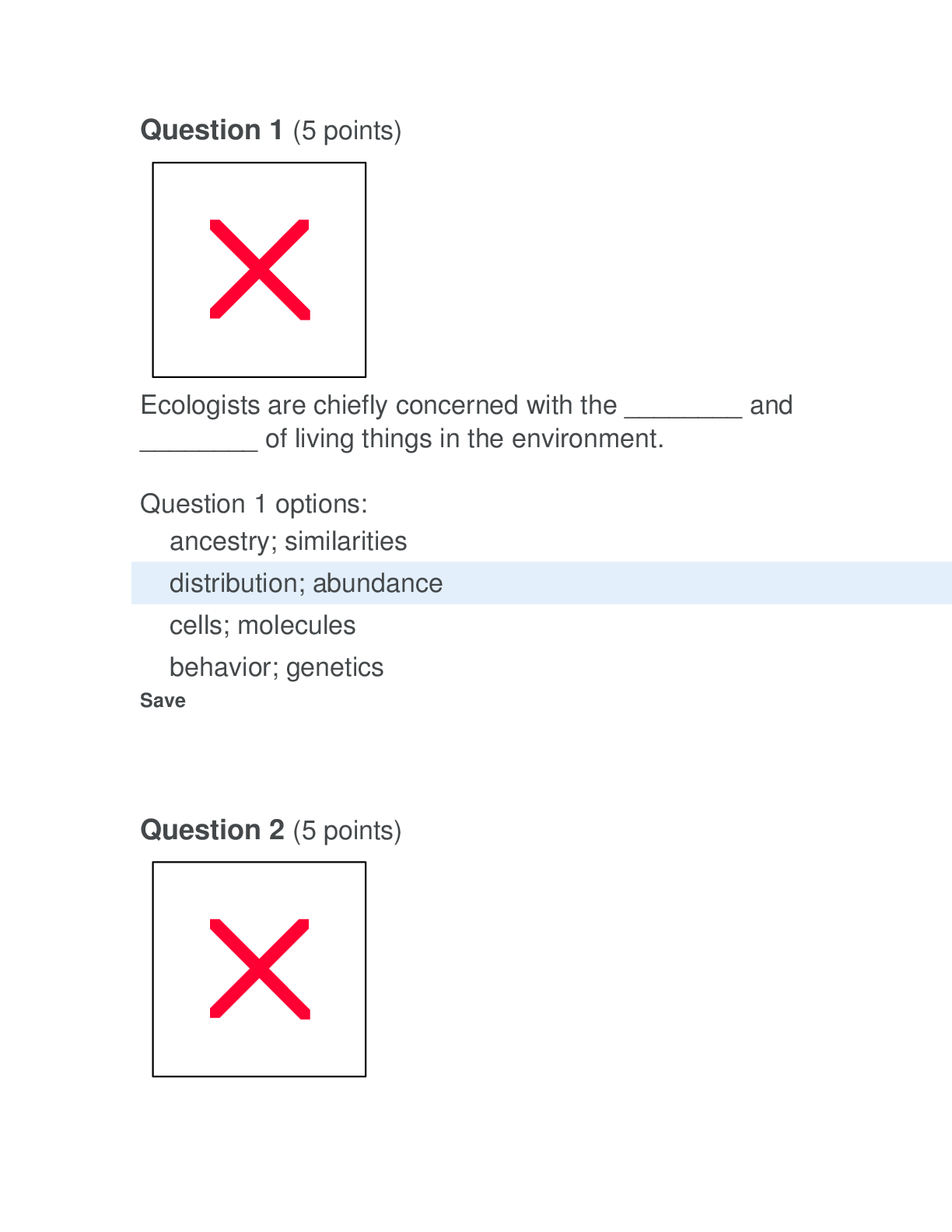
Buy this document to get the full access instantly
Instant Download Access after purchase
Buy NowInstant download
We Accept:

Reviews( 0 )
$13.00
Can't find what you want? Try our AI powered Search
Document information
Connected school, study & course
About the document
Uploaded On
Aug 14, 2022
Number of pages
35
Written in
Additional information
This document has been written for:
Uploaded
Aug 14, 2022
Downloads
0
Views
70



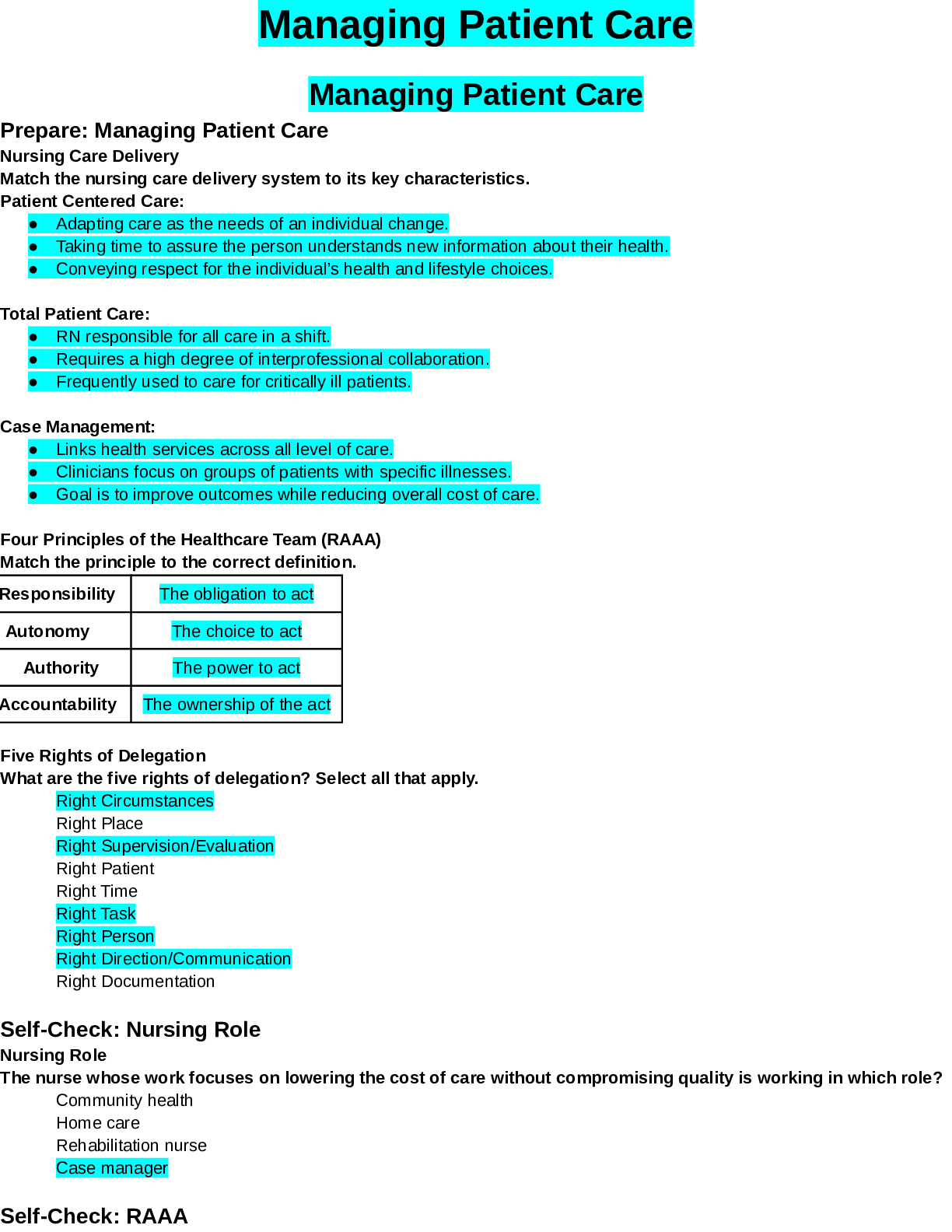




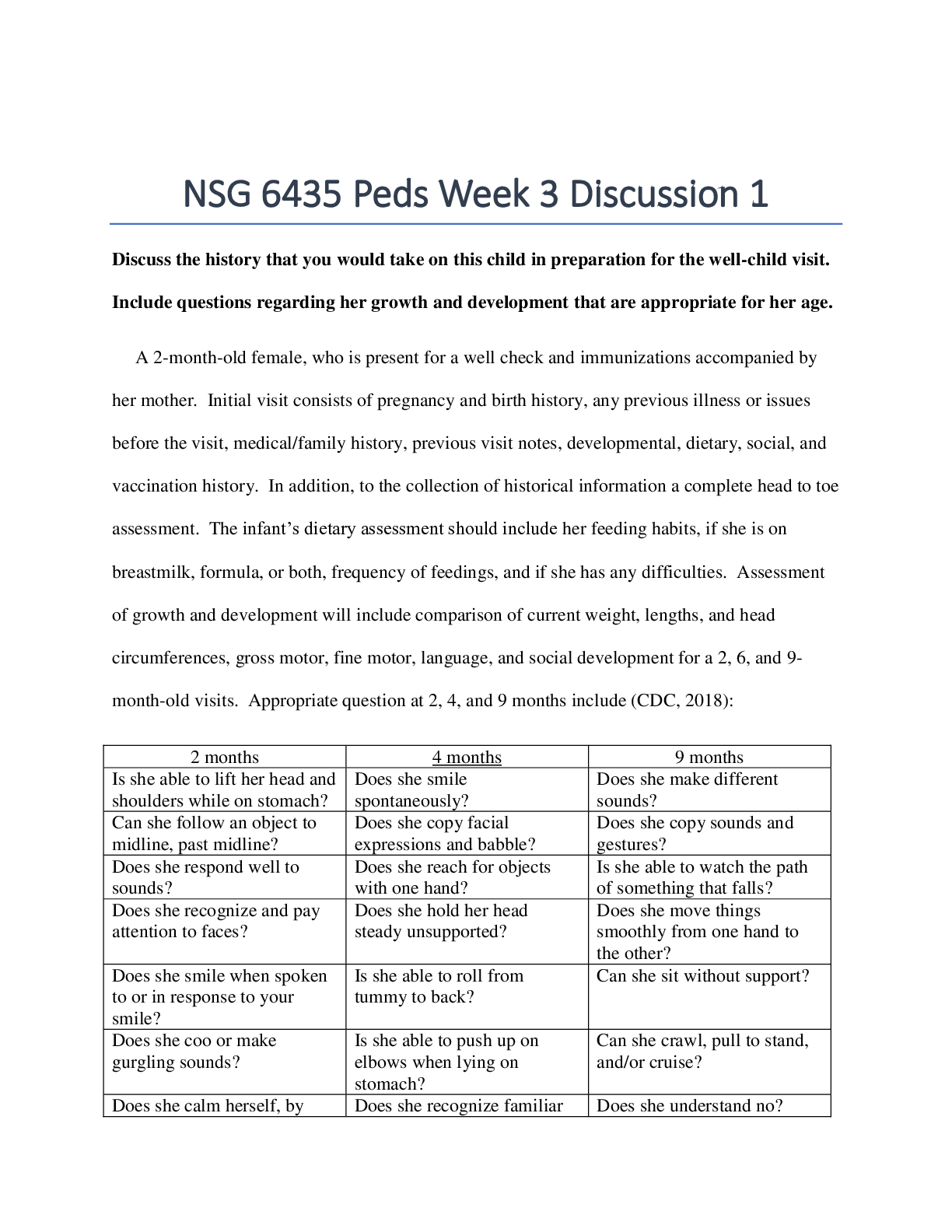
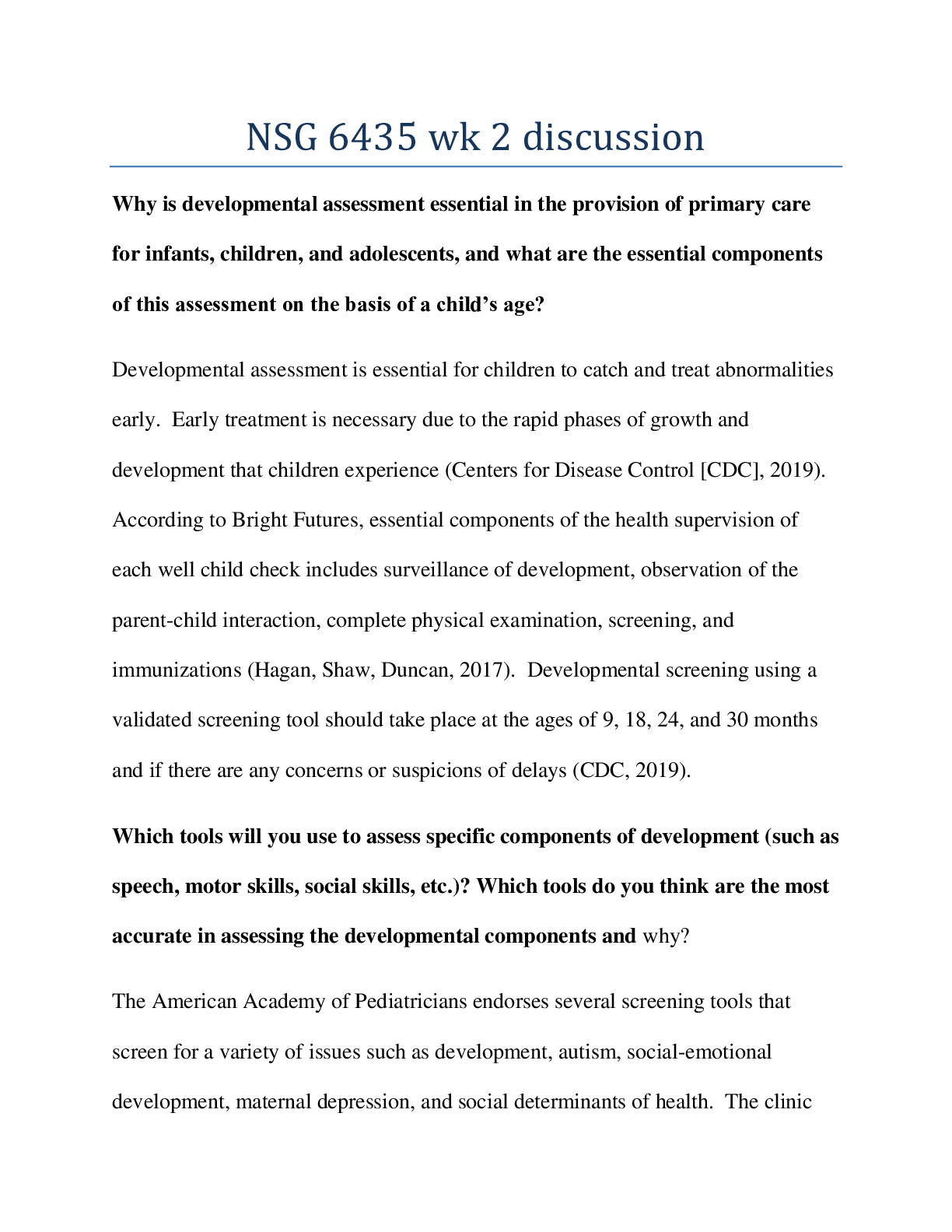


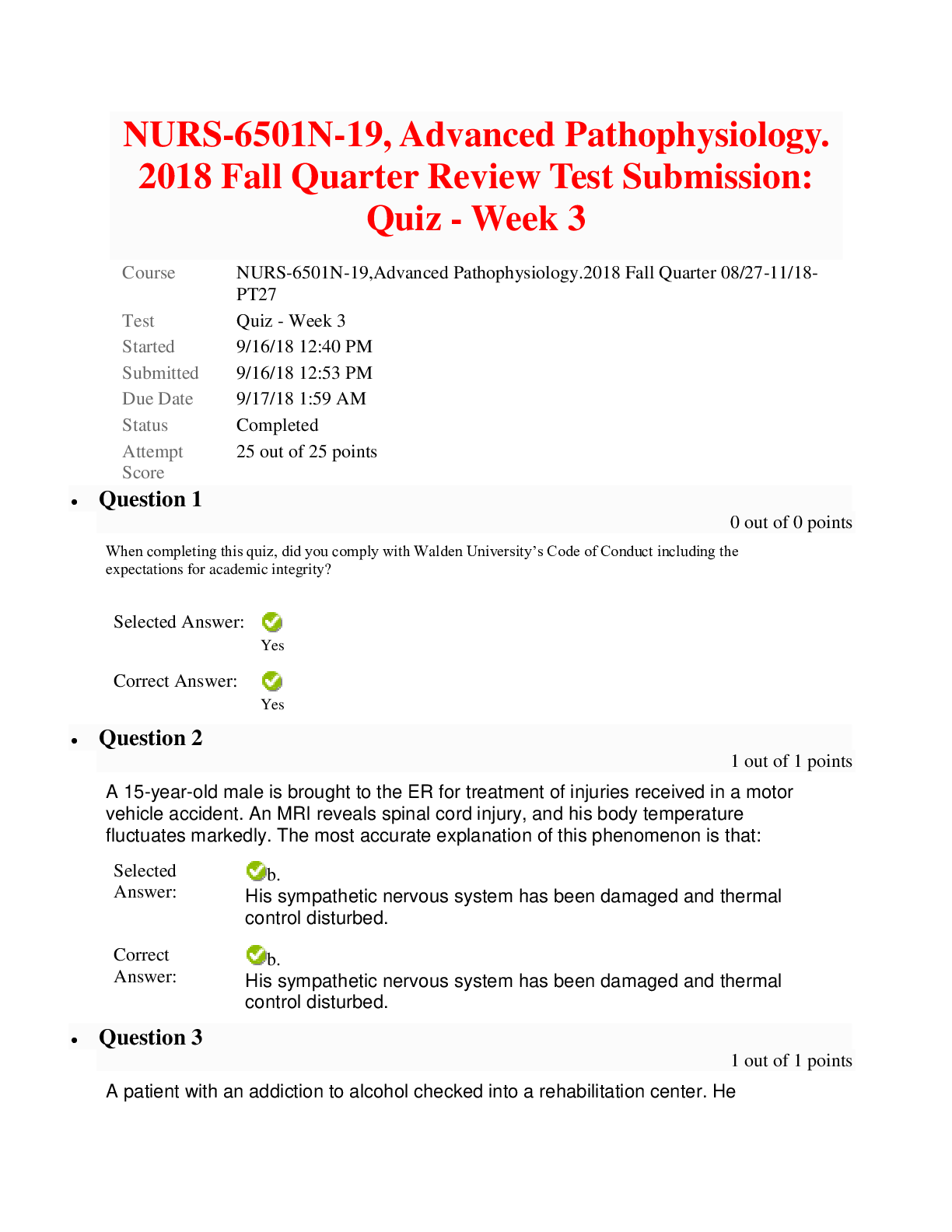
 Chapter 7 Wireless LANS II QUIZ 7 With Answer Key.png)

